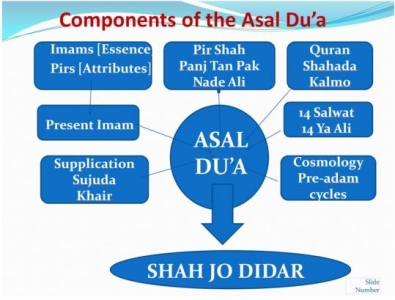Evolution and re-evaluation of the Ismaili Du’a following the Declaration of the Great Resurrection in Alamut.
Evolution and re-evaluation of the Du’a (Prayer ) of the Nizari Ismailis in the subcontinent following the Declaration of the Great Resurrection in Alamut.
There is also a video of this presentation on: https://youtu.be/jjt392ZrXcw
This paper was first presented during the 3rd Ismaili Study Conference in 2021.
The Declaration of the Great Resurrection by the Ismaili Imam Ḥasan ʿAlā Zikrihi's-Salām on 8 August 1164, that is on 17th of Ramadan abolished the Shariah as practiced by Ismailis up to that date, and brought a re-examination of the recitation of the text of the five daily Namaz in the Ismaili community.
Pir Shams arrived in the Indian Sub-Continent around 1,200 CE, few decades after the Declaration. The first reference of the Du’a recited 3 times a day and replacing the previous five daily Namaz can be found in Pir Shams’ Granths. Three generations later, in the 14th Century, that Du`a was revised or completed by Pir Sadardin.
In his judgment of the Haji Bibi Case, Justice Russel recognized from his observation of the Du’as since the time of Imam Aga Hassanali Shah (Aga Khan I) up to 1908 that there were only minor changes in the Du’a through times.
This paper will attempt to show the evolution of the Ismaili Du’a from the time of Imam Nizar II to the present time with particular emphasis on the last two Centuries. It will analyze the evolution of both regular 3 times Du’a known as the Asal Du’a of Pir Sadardin and of his Asal Gat Pat ji Dua which was recited on special occasion during ceremonies of the Holy Water.
The historical Asal Du’a of 17 and 20 chapters composed in Gujrati, Sindhi, Farsi and Arabic and whose recitation was lasting half an hour were shortened to become one unified Arabic Du’a of five minutes introduced for the first time in 1956 in Madagascar, subsequently adapted to newer circumstances and recited in a unified manner three times a day by all Ismailis from 1969 onwards.
The paper draws extensively from primary sources from Khojki Ismaili manuscripts and other sources written in various scripts and languages. The complete text in PDF format is attached below.
| Attachment | Size |
|---|---|
| 2022-01-23-History-of-the-Dua.pdf | 2.62 MB |
- Printer-friendly version
- 3213 reads
 Ismaili.NET - Heritage F.I.E.L.D.
Ismaili.NET - Heritage F.I.E.L.D.